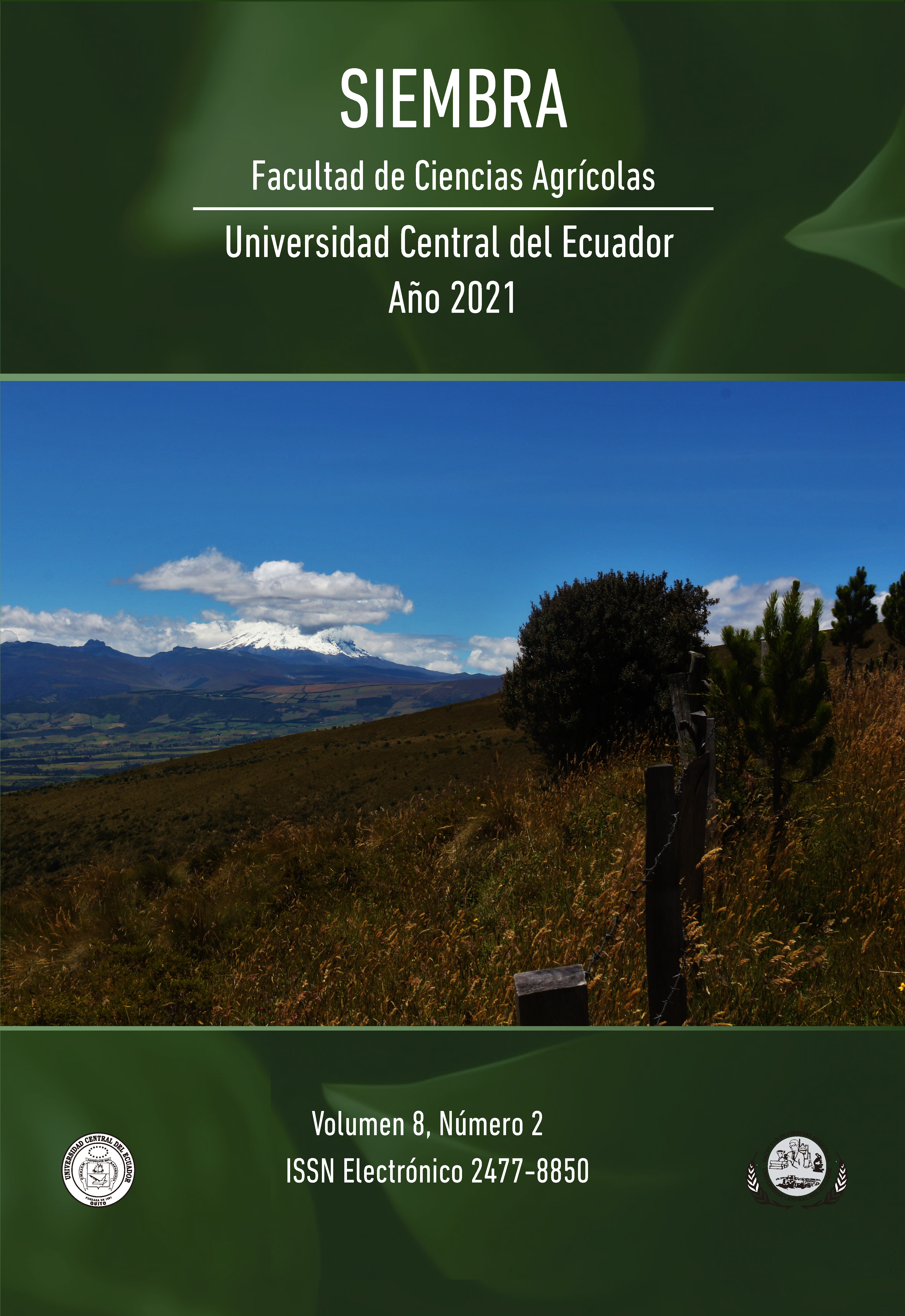Dynamics of the water distribution in the Tumbaco irrigation system in Ecuador
Main Article Content
Abstract
The water distribution to the farmers is the result of the interaction between the irrigation water association, farmers, operation and maintenance of the hydraulic infrastructure. The objective of the research was to identify technical and social aspects linked to the water distribution at the secondary branch canals of the Tumbaco irrigation system. Field information was collected through surveys and interviews to the main actors and measurement of flows in the canals. The main results: i) the construction of the irrigation system began in 1909 by the inhabitants of Tumbaco; in 1944, the “Caja Nacional de Riego” completed the construction of the canal to cover an irrigable area of 2,000 ha; in 2017, the irrigated area was 1050 ha; the water user board has managed the system since 2001; ii) the hydraulic infrastructure of the system has reached its time life (75 years), it has not been rehabilitated and the gates not allow the regulation of the discharges from the main to the secondary canals; iii) regarding the administration, the regulations are not followed in practice. In conclusion, in the Tumbaco irrigation system there is no equity in the water distribution to the farmers because the infrastructure of the system has reached its lifetime, the statute and regulation norms are not accomplished, the rights have not been updated to the needs of the users as a result of the existing process of deterritorialization.
Downloads
Metrics
Article Details

This work is licensed under a Creative Commons Attribution-NonCommercial 4.0 International License.
The authors who publish in Siembra know and accept the following conditions:
- Authors retain the copyright and grant Siembra the right of first publication of the work, under the Creative Commons Attribution License. Third parties are allowed to use what has been published as long as they refer to the author or authors of the work and its publication in this journal.
![]() This content is licensed under a Creative Commons Attribution-Noncommercial 4.0 International (CC BY-NC 4.0).
This content is licensed under a Creative Commons Attribution-Noncommercial 4.0 International (CC BY-NC 4.0).
- Authors maintain the copyright and guarantee Siembra the right to publish the manuscript through the channels it considers appropriate.
- Authors may establish on their own additional agreements for the non-exclusive distribution of the version of the work published in Siembra, acknowledging their initial publication in the same, such as in institutional repositories.
- Authors are authorized to disseminate their work electronically once the manuscript is accepted for publication.
References
Apollin, F., & Eberhart, Ch. (1998). Metodologías de análisis y diagnóstico de sistemas de riego campesino.CAMAREN. CESA. CICDA – RURALTER.
Carrera, G. (2015). Tumbaco de antaño. Da Vinci Corporación Gráfica.
Chávez-Jiménez, A., & González-Zeas, D. (2015). El impacto de los caudales medioambientales en la satisfacción de la demanda de agua bajo escenarios de cambio climático. Ribagua, 2(1), 3-13. https://doi.org/10.1016/j.riba.2015.04.001 DOI: https://doi.org/10.1016/j.riba.2015.04.001
Chesini, F. (2018). Los desafíos sanitarios del cambio climático en Argentina. Ingeniería sanitaria y ambiental, 134, 34-37.
Gallardo, G. (1987). Políticas de riego en el Ecuador. En E. Kingman (ed.), Riego en los Andes ecuatorianos (pp. 87-98). CAAP. http://hdl.handle.net/10469/9892
Gobierno Autónomo Descentralizado de la Provincia de Pichincha [GADDP]. (2013). Diagnóstico de riego y drenaje de la provincia de Pichincha. GADDP. http://sitp.pichincha.gob.ec/repositorio/diseno_paginas/archivos/Diagn%C3%B3stico%20de%20Riego%20y%20Drenaje%20de%20la%20provincia%20de%20Pichincha.pdf
Gutiérrez, Z., & Gerbrandy, G. (1998). Distribución del agua, organización social y equidad en el pensamiento andino. En R. Boelens & G. Dávila (eds.), Buscando la equidad: concepciones sobre justicia y equidad en el riego campesino (pp. 259-268). Van Gorcum.
Hernández, Y. (2016). Efectos del cambio climático en registros de temperatura y precipitación en la ciudad de Quito, Ecuador. Escuela Politécnica Nacional.
Herreras, J. E. (1991). Monografía de la parroquia de Tumbaco. Talleres Abya Yala.
Instituto Ecuatoriano de Recursos Hidraúlicos [INERHI]. (1973). Proyectos del INERHI. Biblioteca Ecuatoriana Aurelio Espinosa Pólit.
Instituto Nacional de Meteorología e Hidrología [INAMHI]. (2018). Datos climáticos. INAMHI.
Junta de Riego Tumbaco [JGUSIRTUM]. (2017) Estatuto y Reglamento de Operación y Mantenimiento de la Junta de Riego Tumbaco, 2017. JGUSIRTUM.
Junta de Riego Tumbaco [JGUSIRTUM]. (2019) Archivos de la Junta, 2019. JGUSIRTUM.
Martínez Carazo, P. C. (2006). El método de estudio de caso: estrategia metodológica de la investigación científica. Pensamiento y Gestión, 20, 165-193. https://rcientificas.uninorte.edu.co/index.php/pensamiento/article/view/3576
Martínez, J. (2011). Métodos de investigación cualitativa. Silogismo 1(8), 25-38. http://www.cide.edu.co/ojs/index.php/silogismo/article/view/64/53
Montúfar, C. (2017). Catastro del sistema de riego Tumbaco. Universidad Central del Ecuador.
Olazaval, H., Noordholland de Jong, J., & Alvear, J. (1999). Infraestructura del riego. Elementos técnicos y sociales. INDUGRAF del Ecuador.
Ortiz, R. (2019). Guía Metodologica. Infraestructura de riego de la Escuela Nacional de Irrigación Productiva. Ministerio de Agricultura, Acuacultura y Pesca.
Ortiz, R. S., & Chile A. M. (2020). Métodos de cálculo para estimar la evapotranspiración de referencia para el Valle de Tumbaco. Siembra, 7(1), 070–079. https://doi.org/10.29166/siembra.v7i1.1450 DOI: https://doi.org/10.29166/siembra.v7i1.1450
Pons, J. (1948). Fomento de la Agricultura y la Caja Nacional de Riego. Biblioteca Ecuatoriana Aurelio Espinosa Pólit.
Sarricolea, P., Ruiz, Ó. M., & Aravena, H. (2017). Tendencias de la precipitación en el norte grande de Chile y su relación con las proyecciones de cambio climático. Diálogo Andino, 54, 41-50. http://dx.doi.org/10.4067/S0719-26812017000300041 DOI: https://doi.org/10.4067/S0719-26812017000300041
Tamayo, C. (2015). Análisis de las economías campesinas en la acequia Mocha-Huachi. Provincia de Tungurahua. Universidad Central del Ecuador.
Tamayo, C. (2016). Caracterización básica del área de influencia del sistema de riego Tumbaco. Universidad Central del Ecuador
Tamayo, M. (2004). El proceso de la investigación científica. Limusa / Noriega Editores.
Tovar, L., & Anyela, R. (2020). Calibración de la canaleta Parshal. Universidad Cooperativa de Colombia.
Valdivieso Armijos, S. (2013). Análisis de un proceso de desconcentración y descentralización en el Ecuador: estudio de caso. “La transferencia de la competencia de riego en la provincia de Pichincha. IAEN - Instituto de Altos Estudios Nacionales - Universidad de Posgrado del Estado.





